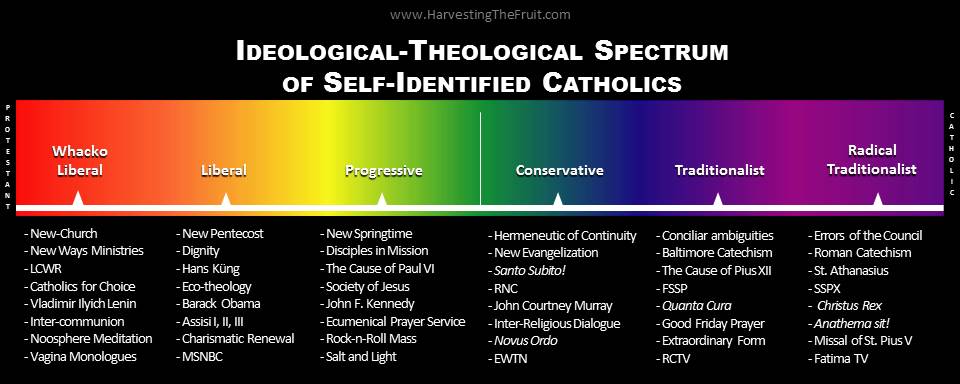Left wing, right wing, progressive, conservative… and on and on it goes. Sure, these are largely political terms, but we use them to refer to one another in the Church, and for the most part, all of us have a pretty good idea of what they mean. Heck, we even use them to refer to ourselves sometimes.
At any rate, I’ve been thinking about this “ideological-theological spectrum” lately, and I put together the graphic below. (I have to admit, I amused the daylights out of myself in the process.)
Now, it’s far from perfect. There’s definitely some cross-over between the categories and the various elements placed in each one, but it’s a pretty good start. (Click on the image. It’ll be easier to read.)
Feel free to chime in with your own input.

Why are the SSPX all the way to the right? Wouldn’t that be more for the sedes and SSVP types? I would also say that the Roman Catechism, St. Athanasius, the Missal of Pope St. Pius V, and anathemas are very traditional, and refering to them as radical seems a bit much.
You’re assuming that “radical” is a bad thing, okiepapist. I don’t think so.
https://akacatholic.com/all-traditionalists-are-radical/
Good breakdown. I would say in the traditionalist camp it’s not just the Extraordinary form but the objective superiority of the Extraordinary form over the Novus Ordo (but that’s probably too long to fit on a graph).
Louie, this is pretty good and funny too (in a way). There certainly are a lot of cross-overs. I attend Novus Ordo mass but consider myself to be traditional. I don’t like all the new feel-good things about it, but there is nothing I can do. I have to disagree with SSPX being radical traditional. They are in a sense, but if radical is good then they fall short. I sympathize with their concerns, but the bottom line is that they were disobedient. Maybe they thought the salvation of souls was in the balance. Maybe that is what Martin Luther thought as well. Saint Pio was persecuted by the Church, yet he was obedient through it all.
Gosh, I’m apparently a Radical Traditionalist. And as you suggest, that’s a good thing!
Me too, Elizabeth!
I just watched your video “Fix Church Division by Proclaiming the Kingship of Christ”
https://www.youtube.com/watch?v=Kc42JQF3wg8&feature=c4-overview&list=UUX17igkZ9JhU64JoTBVSWeQ
Thank you for making Mr. Voris aware of the Ramadan greetings of Pope Francis!
In your spectrum above I missed one category: the ultra-radical Traditionalist who would add to the issues of the “radical tradionalist” and of the “Traditionalist” the following: the Fathers of the Church, the Doctors of the Church, the Dogmas of the Catholic Church, the Saints.
Regarding the SSPX, I think it is not traditional Catholicism at all to consecrate four new bishops without permission of the Pope no matter how grave the crisis of the Church is.
This is cool. Although I’d put protestant on the far right and far left, outside the spectrum. We could argue if lcwr is Catholic,or the sedevecantists. The novus ordo range the spectrum unfortunately.
Great work, and I imagine it was fun to make. In my mind your graph is remarkably accurate, and I am exactly what I thought: a traditionalist. I think many of the conservative types were beginning to trend in the traditional direction, but that has changed with Benedict’s abdication.
I think the two main obstacles to move from conservative to traditional (as myself, Louie and many others have done)–aside from doing the necessary reading–is letting go of one’s americanism (belief in America’s founding, the efficacy of America’s exports: materialism, cultural entertainment/ideals and military power abroad) and the contemporary understanding of worship. The TLM and sacred music open the door to a much deeper and ancient experience of worship.
Thanks!
‘Til now I was unaware of Fatima TV!
alan
According to this chart, I’m probably a semi-radical traditionalist. Lol
Louie, I am so glad you had fun making this chart. In your comment, you refute the assumption that “radical” is a bad thing. However, on the other side of the spectrum you chose to use the term “whacko,” which has an undeniably negative connotation. I would love to know why you think this sort of blatant bigotry is acceptable.